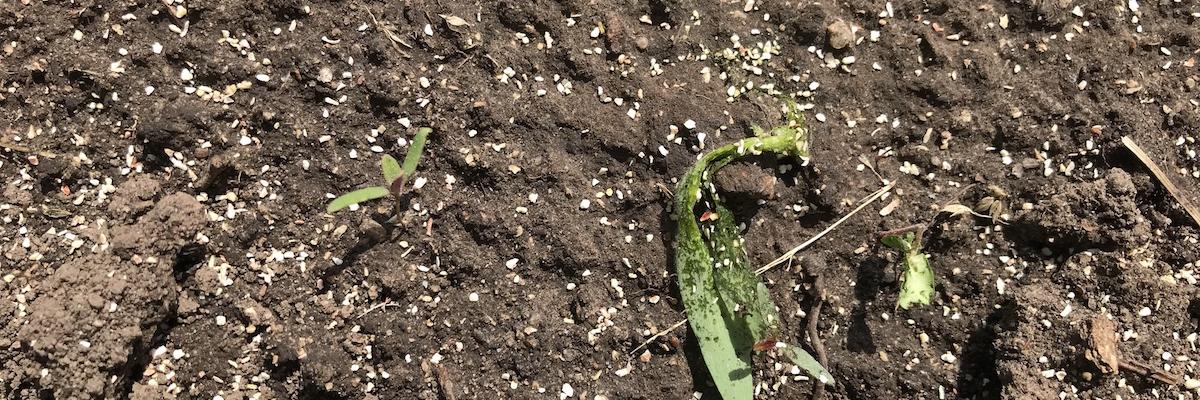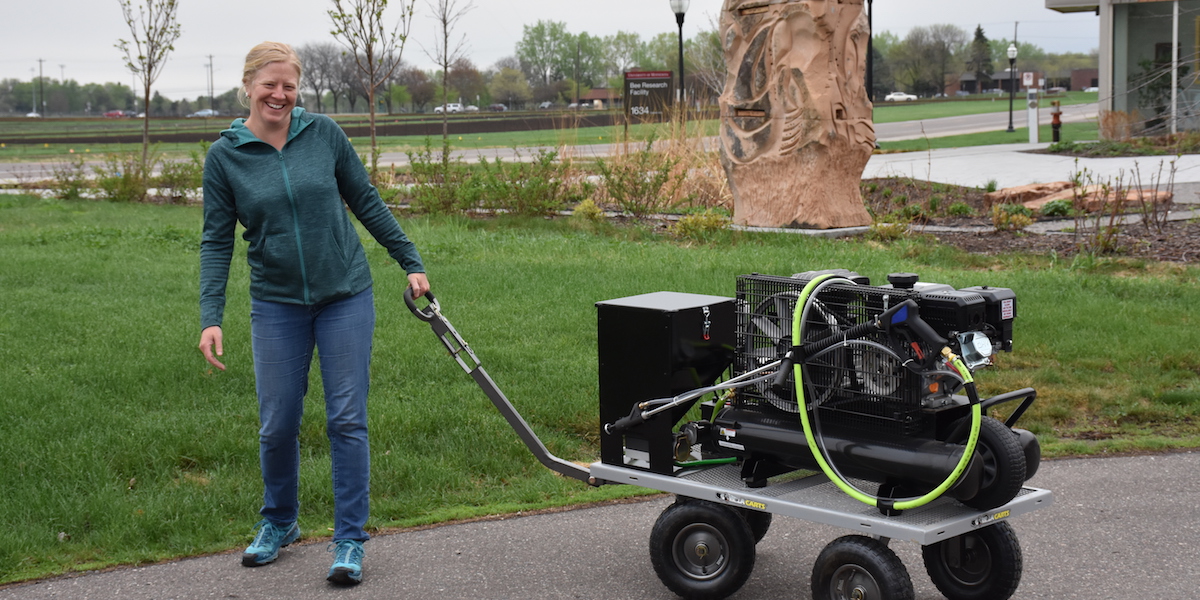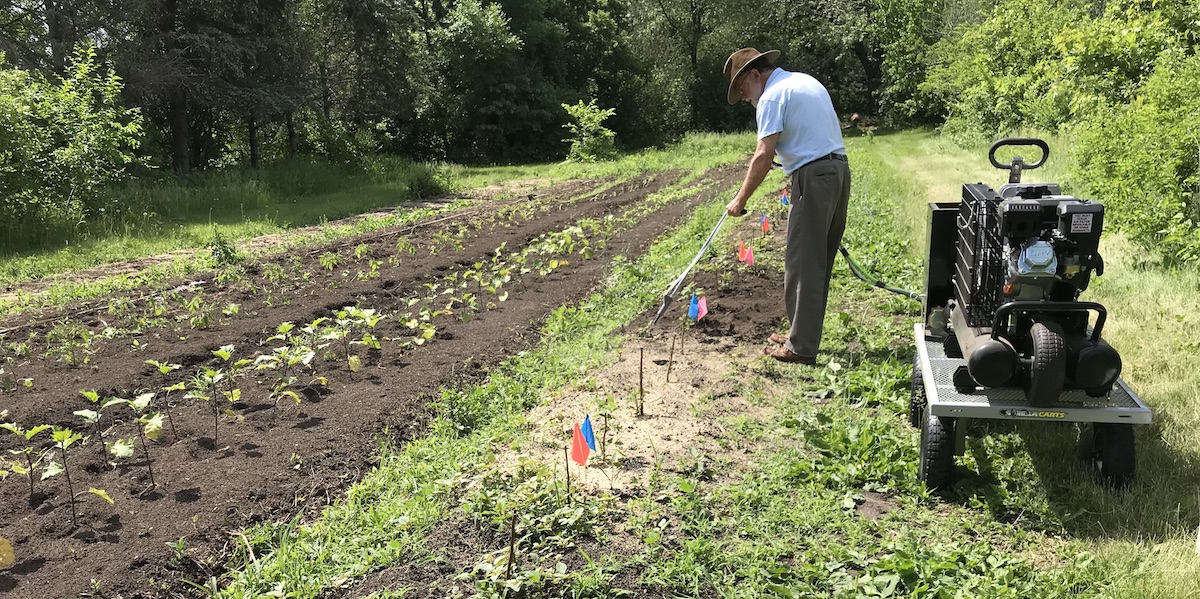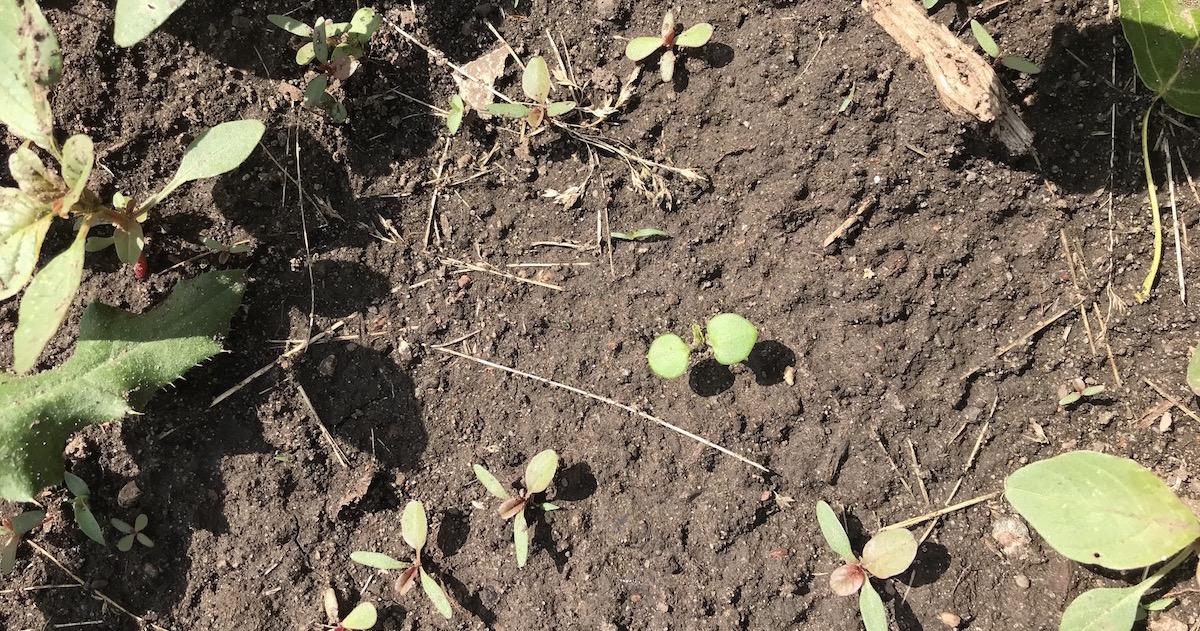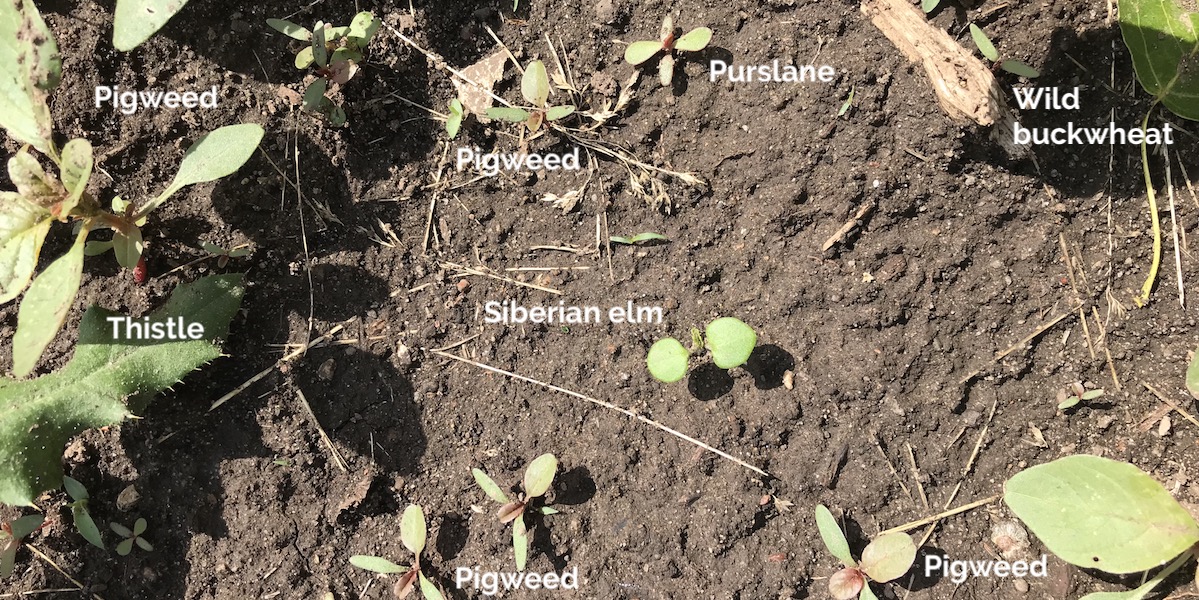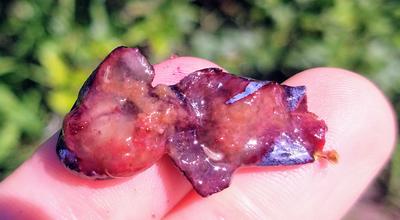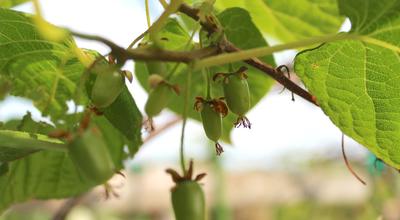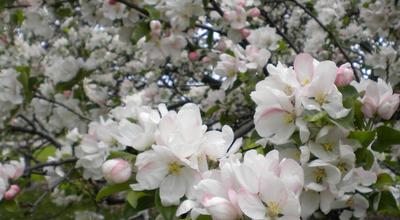A new approach to weed control
Ask any fruit grower in Minnesota to list their top 5 challenges and chances are one of those is weed control. The Fruit Research team at the U of M tries to address that challenge by looking for inexpensive, effective, and sustainable weed control methods. This year, thanks to a grant from the Minnesota Department of Agriculture, we started to investigate a new and exciting method called grit weeding.
Grit weeding is a practice in which an abrasive material, typically an agricultural residue such as ground corn cobs, walnut shells, or even apricot pits, is blasted by compressed air at weed seedlings. In past projects, we’ve found it effective for controlling actively growing weeds in corn, soybean, tomato, and pepper. We hope to find it equally as effective in new and established fruit plantings.
Our grit weeders are designed and built by a team of agricultural engineers at South Dakota State University. The team modifies existing equipment, adds some custom-designed componets, and mounts it all on a hand cart or on a trailer that can be pulled by a small tractor. Here's a look at the latest version. This one uses an air compressor that pulls grit from an attached hopper. There are two hoses, one for the air and one for the grit, that lead to a long pressure washing gun with a trigger handle. We aim the gun at the weeds, pull the trigger, and the compressed air forces the grit out the nozzle and at the weed seedlings. There's no bending, crouching, or kneeling.
Why are we doing this?
Weeds compete with crop plants for water and nutrients, and if they are left to grow they sap nutrients from the soil, harbor pests and diseases, and can significantly reduce yield. Since most fruit crops are perennial plants, cover crops and tillage are not viable options. Growers might typically look to herbicides for in-row weed management, but many herbicides are not labeled for use in fruit crops. For the few herbicides that are allowed, growers have concerns about cost, environmental impacts, and effectiveness, especially in new plantings when crops are most vulnerable to weed pressure.
Many growers resort to hand weeding which is time consuming and labor intensive. Mulch can help reduce weed seed germination, but any weeds that do germinate still need to be removed by herbicides or hand weeding. Surprisingly, there has been little research on successful alternative weed control strategies for perennial fruit crops. Grit weeding has the potential to be effective, so we just had to look in to it!
Farmers guide our research
Before we embark on this kind of research, we want to be sure it is something growers really need. There are several organizations in Minnesota that we work with to plan research that addresses problems faced by large numbers of growers. The Minnesota Fruit and Vegetable Growers Association represents a wide range of fruit and other specialty crop growers and has a long history of partnership with the University of Minnesota. The Minnesota Apple Growers Association represents commercial apple growers across the state. With the growing demand for pesticide-free apples, many orchard owners are interested in alternative weed control options like grit weeding. The Southern Minnesota Wine Grower Alliance represents many grape growers who are looking for effective weed control options since they are limited for grape production systems. These and other groups help us determine the greatest research needs, and offer support by helping spread the word and educate growers about the work we do. They invite us to write articles for their newsletters, and give presentations at their conferences and field days so our research findings benefit the greatest number of growers.
We couldn’t do any of this work without the help of our grower-cooperators. These are local growers who help us plan the details of our research and offer land or plantings for us to test our experimental methods. These growers are active participants in the research and give us valuable, on-the-ground feedback about the practicality of adopting the new systems we develop. They also participate in field days and presentations to help educate their fellow growers on new techniques and practices.
Which fruit crops are we working on?
In this project, we are investigating how well grit weeding can control weeds in raspberry, apple, and grape plantings. The 2012 USDA Census of Agriculture shows that about 1270 Minnesota farms produce apples, grapes, and/or raspberries. Since weed control is a challenge for all of them, we chose to use all three for our research.
The nitty gritty
Are you curious how we actually do this type of research? It takes a lot of planning, and we need to keep very close track of all aspects so we can accurately compare our new methods to existing ones. Here’s how this project is organized.
We established research plots in Spring 2018 at three locations: the U of M West Central Research and Outreach Center in Morris, MN, Fairhaven Farm in South Haven, MN, and Prairie Horizons Farm in Starbuck, MN.
Plots, treatments, and data
We randomize the treatments to get an unbiased look at how the different treatments work at the different locations. We arrange plots in a randomized complete block design with three treatments and four replications. We measure out the rows and divide them into equal size plots. Then we randomly assign a treatment to each plot. We create simple maps of each location and use colored flags to mark the field to help us keep track of which treatments go where. The size of the plots varies by crop and the plant spacing used by our grower-cooperators.
Our three treatments in this project are hand weed, grit weed, and weedy check. Each week from spring to late summer we go out to each planting, clip board and data sheets in hand, and get weeding. In the hand weed plots, we use a hoe to remove all the weeds. In the grit weed plots, we fire up the grit weeding machine and blast all the weeds. We have to get them when they’re small, with only one or two sets of leaves. Once they get bigger than that, the grit doesn’t damage them enough to control them. We keep track of the time it takes to do the hand and grit weeding. For the grit weed plots, we also keep track of the amount of grit we use in each plot, and the energy used by the machine.So what about that third treatment, the weedy check? The weedy check is our control. We don’t do anything to these plots, we just let the weeds grow. You might wonder why we do this, since no smart grower would just leave the weeds in their field. It’s actually quite important to our research. Since our plantings are at three locations spread across the state, the number and variety of weeds differs. The weedy check allows us to see what uncontrolled weed pressure looks like at each location. When we can see the weeds at their worst, we can compare our two other treatments more accurately and see how effective they really are.
Each week, we also estimate the approximate weed cover in the plots and make a note of the predominant weed species before hand weeding or grit weeding. This helps us keep track of how effective grit weeding is on different species of weeds. Yes, we actually crawl around on the ground and look closely at the seedlings and estimate the numbers of each species. Can you identify the weeds in this photo? Keep reading to find out if you got them right.
In late summer when most of the weeds have stopped germinating, we measure the above-ground weed biomass. That means we harvest the weeds, but only the parts of the weeds above the ground. We don’t include the roots. We clip the weeds in each plot, then dry them and record the weights. This tells us how effective our different treatments were at controlling weed growth.
We also need to see how crop growth is affected by the different treatments. We assume that the crop plants in the weedy check will not grow as well as the ones in the hand weed and grit weed plots. We monitor crop growth over both seasons by measuring current-year growth. We also record fruit yield and quality. We harvest apples and grapes once each season, and harvest raspberries as needed, just as our grower-cooperators would do. We weigh the fruit and assess other quality attributes.
We will do all of this for two seasons. Right now, in August 2018, we're part way through our first year. We have finished grit weeding, and we have harvested and weighed the weeds. We still need to harvest and measure current-year growth of our crop plants.
What does it all mean?
Weed management is a moving target. Throughout the season and through the years weed species change, weed densities shift, and weed development alters depending on weather and other factors. Most growers continually adapt their weed control strategies to keep up. We don’t expect that grit weeding will be the silver bullet for weed control in fruit crops. What we do hope is that it will give growers another tool to add to their weed control tool shed, so to speak. We already know that grit weeding can control weeds, but we do not know yet how well it can be integrated into a farmer’s established practices. In this project we plan to figure that out.
Research like this is exciting because the results are clear and practical. We adapt and build upon what we learn each year to refine these innovative systems, so we can share the very best info with growers. We’re eager to see how grit weeding works in perennial fruit plantings, and we’ll continue to share updates and results as they come in. Stay tuned!
This project is made possible through funding from the Minnesota Department of Agriculture Specialty Crops Block Grant program.
